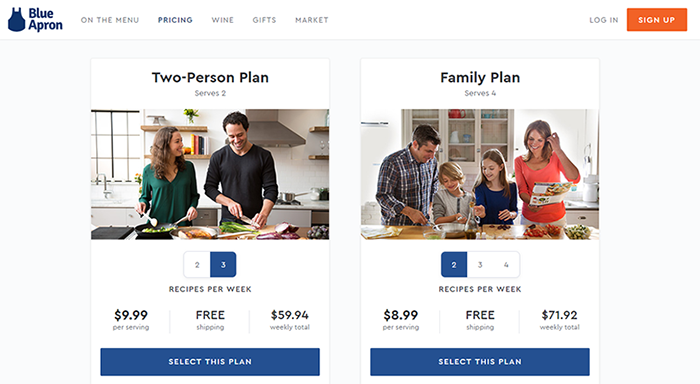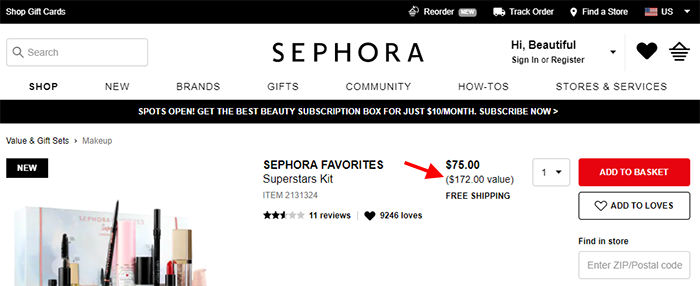Wherever you look, it seems like price bundling is making inroads into new industries. A plane ticket and travel insurance? Check. A facial with some skincare products to take home? Check. A pair of shoes with some socks? Check.
There’s a good reason for this. Price bundling, also commonly known as package bundling, is a sales and marketing tactic used to demonstrate higher perceived value to customers. If customers purchase just one product, they pay a certain amount. But if they opt-in and purchase a bundle with two or more products, it costs more overall but is cheaper than buying those products separately. In 2017, The Comcast Corporation generated more than $ 84.5 billion, with over 21 million subscribers. How does a company stay fiscally healthy, particularly after the growing trend of ‘cutting the cable cord’?
Now, cable television is only one piece of the package that Comcast offers—the other two major players being Internet access and voice packages, whether it’s on a landline, a cell phone, or both.
However, Comcast is far from the only service provider to embrace bundle pricing. Subscription-based businesses, especially SaaS companies, are effectively using the price bundling tactic to grow and retain their customer base by bringing together different features and add-ons to create plans. Software giants such as Microsoft have also had tremendous success with bundling products—in fact, they increased their market share from 7% to 38% when they first bundled popular products like Access, PowerPoint, Word, and Excel.
However, creating a successful product bundle is a fine art. There needs to be a good understanding of your target customer and how to target their needs effectively, as well as a strong marketing strategy to spotlight your bundle and drive demand.
In this blog, we’re diving into how you can implement successful bundle pricing and manage marketing and sales effectively.
TL;DR
- Bundle pricing combines complementary products/services sold at a lower price to increase perceived value
- Bundling helps to simplify buying decisions for time-poor customers and also offers a way to shift underperforming or overstocked items.
- Successful bundles must offer customers genuine savings and convenience, as well as highlight the value of purchasing the bundle rather than individual items.
What is bundle pricing (A.K.A price bundling?)
Bundle pricing is a pricing strategy where several complementary products or services are packaged together and sold at a lower price to boost sales.
Because the individual items present in a bundle are sold for a higher price independently, this increases the perceived value of the bundle to potential customers, while also helping to raise average order values.
A bundle pricing strategy usually focuses on combining popular products or services with aligned add-ons or new products. This adds convenience to the buying experience for time-poor customers and helps to simplify purchasing decisions.
Moreover, bundling offers a great way for merchants to shift SKUs that are underperforming or overstocked by repositioning that item’s value proposition as part of a bundle, rather than as individual products. A solid product bundle pricing strategy offers a powerful competitive advantage in eCommerce, where generic items can be purchased from a variety of different vendors. Bundling items appropriately and using competitive pricing can drive sales while helping to build better market share.
The psychology of package bundling
Bundling might offer consumers a more attractive price point. But what is it that makes bundled offers desirable?
Keep in mind that the perception of value is critical from the customers’ point of view. Value isn’t just a monetary measure—value perception can also be psychological, functional, or social.
Decision fatigue. Trying to find appropriate products or services can get overwhelming, especially when there are so many options out there. Bundling simplifies the decision-making process for consumers by reducing the number of choices they have to make during the shopping journey. This means faster, easier purchasing decisions.
Usefulness. Bundling the right products together can create a genuinely useful offering that targets multiple consumer pain points. If a customer can get related or complementary products in a single purchase, this saves valuable time and effort.
Perceptions of scarcity. If your bundle’s marketing strategy focuses on exclusivity and limited-time offers, this helps to drive the illusion of scarcity and stimulate urgency to purchase. Exclusive offers that are only available to some customers can also make shoppers feel valued, which increases customer satisfaction.
Advantages of bundle pricing
As a business, there are several different reasons why price bundling is an effective pricing strategy. Selling bundled products can:
Increase the average sale amount
If a customer comes to you because they want to purchase 1 widget, they will see the value in purchasing that widget and spending a little extra to buy 1 widget and 1 sprocket.
Increase overall sales volume
Because customers are enticed to purchase a package deal as opposed to single items, this is highly beneficial for your bottom line. Bundles effectively come at a discounted price for the products they contain, so this more attractive price point helps to convert both existing and new customers.
Decrease marketing costs
With a single price and a strong convenience factor, product bundles have a compelling value proposition and are easy to market, both organically and via paid advertising. Rather than trying to advertise individual items separately, marketing them as part of their own bundle of related products is a much more compelling offer.
Increase the profit margins
Price bundling is an effective way to increase profit margins with very little increase in the cost of sales. While each item is likely to be sold at a slightly lower margin individually, A bundling strategy helps to increase profitability due to the higher volume of sales and lower marketing costs. Moreover, the greater efficiency of preparing orders that involve product bundles (i.e. picking and packing bundles for shipping ahead of time) means the cost to fulfill is lower than it is for an entirely custom order, which can only be picked and picked upon being received and processed.
Increase customer loyalty and reduce churn
Bundling goods or services helps to promote customer loyalty more than standalone products, as a bundled purchase of several items is more likely to provoke higher customer satisfaction. Even if a customer is unsatisfied with one of the products in a bundle, there are still several others that might fit their needs.
Remind customers to buy complementary products
Bundling products is also a good way to alert buyers that additional products are needed to enjoy the product without interruption. Otherwise, a customer might purchase a specific product and find themselves unable to make use of it, leading to frustration. For example, you can bundle items such as printers and ink cartridges, socks and sneakers, or notepads and pens for a competitive price to drive higher order values and increase customer satisfaction.
How does bundling work?
There are four major ways that bundle pricing works within a retail setting:
Bundling multiple complementary products. Bundle pricing makes it easy for businesses to combine different types of products that consumers are likely to purchase together. For example, fast food restaurants frequently create value meal deals out of separate food items at a different price than selling them individually.
Combining a product sale with future services. Bundling together products and services that are usually purchased hand in hand offers consumers a high level of convenience. Think purchasing a vehicle with an extended warranty for service, or a laptop with a Microsoft Office subscription.
Bundling related products. Bundling together products that share a certain theme or function is a good way to entice customers. If they’re interested in one of these items, there’s a high likelihood they’ll be interested in similar products. This could mean books by the same author or that share the same topic.
Combining a product with alternative products. With Comcast, a customer can purchase different internet speeds, different channel packages for the television, and a variety of minutes and data for voice.
Top bundle pricing examples
One of the most talked about bundle pricing strategies is Nintendo’s video console and game bundling. Harvard researcher Vineet Kumar and Carnegie Mellon University researcher Timothy Derdenger looked at the handheld game market for four years, beginning in 2001.
Nintendo tried two different bundling tactics:
Mixed bundling. The company offered a two-tiered sales approach in which a customer could buy a game system unit bundled with a game or they could buy the two separately.
Pure bundling. At another point, Nintendo forced the bundling option. Here, the customer didn’t have the option to buy the game unit or the game separately—instead, customers had to purchase the bundled option.
According to Kumar and Derdenger’s findings, customers preferred the mixed bundling option, where they could purchase the bundle or a unit separately. When this option was offered to customers, Nintendo sold about 100,000 more game units, and video game sales increased by more than a million games.
When the pure bundling was the sole purchase option, sales revenue dropped more than 20 percent—millions fewer game units were sold and sales of games fell by over 10 million pieces.
Put simply, Nintendo found that bundles performed better when they were separate, distinct products in their own right, rather than the only option available. This type of bundle pricing created a stronger value proposition and sense of convenience by contrasting with the individual product offerings.
Tips to package and price bundling
To effectively leverage bundle pricing, here are some other ideas to keep in mind:
Conduct product analysis
First, it’s important to take a good look at your products. A product analysis will not only reveal your top-selling products but also your most sluggishly moving products. Combining fast and slow-moving products into a compelling bundle is a great way to minimize the build-up of excess inventory and diversify your product offerings.
Gather customer feedback
Look at your customer data. What is selling and what are customers frequently buying at the same time? When you look to buy something on Amazon, their analytics-driven algorithms are immediately going to tell you what other people are buying. For example, if you’re considering purchasing a printer, Amazon will tell you that Printer X is often purchased with a specific kind of ink and a certain kind of printer paper. This can help you to zero in on what kinds of bundles are going to drive conversions.
Create visibility in your package options
Make it easy for customers to compare different pricing and bundle options to understand where the cost savings are. On Blue Apron’s pricing page, the options are front and center. Do you want to purchase meal kits for a two-member family or a four-member family? How many recipes do you want a week? As few as 2 or as many as 4? These different selections allow customers to seamlessly vet different combinations and find the best deal for their needs.

Highlight the savings
As customers are looking for the perceived value in their purchase, they need to understand how much a single item would cost, then that item bundled with other goods or services. Cosmetic companies have been offering their goods in bundles for years. Yes, so you spent $75 on Sephora’s superstars kit … but it’s valued at $172!

Create a separate page for value packages
Customers who are looking for increased value at lower costs are going to dig into your website to look for a good package deal. If your bundled items are seasonal , such as a back-to-school promotion or a holiday season offer, you’ll want to be able to pull that page when the deal is over.
Offer bundled packages at the checkout
A customer may not be interested or aware of a product bundle when he selects an individual item for purchase, but that first or second look at the checkout page might trigger an additional purchase. For example, your customer may decide upon more reflection that it is a good idea to purchase the optional 2-year warranty on that $500 television after all.
Consider how you will manage recurring billing
Price bundling is an important strategy in a recurring revenue model. However, adding new package deals to your site will increase billing complexity and may lead to longer go-to-market times. Subscription management and recurring billing software like Stax Bill offer the scalability to launch different bundling with just a few clicks.
How to make price bundling a part of your success story
It’s easy enough to create a product bundle on the backend of your eCommerce platform and spotlight it on your home page. But this doesn’t mean it’s going to attract high demand from your customers. Whenever you set up a product bundle package, you should ask yourself the following questions:
- Will this bundle make sense to my prospective customer?
- Are the savings enticing enough to showcase genuine value?
- Is your product something that the customer will see as helpful, rather than a ‘money grab?’
If the answer to all of the above is ‘yes’, this is a good sign that your bundle has a strong value proposition that will attract a lot of sales. Businesses find the most fiscal success with price bundling when:
Customers understand the value of the bundled products. Make sure that you clearly communicate not only the cost savings of a bundle, but also the overall value of the items it contains. This is a far more compelling sales pitch than just “get $x off as part of a bundle.”
It simplifies the purchasing decision. If you can bring together a range of items that customers typically purchase together – and may even have to shop at multiple stores for normally – this increases the perceived convenience and increases the likelihood of a sale.
Customer acquisition costs are high. It’s costing merchants more every year in marketing and ad spend to acquire customers. When competition is so high, the margins on individual items is eroding further. A bundle which brings together desirable items into one offering is more likely to be a competitive differentiator and give you an edge over other vendors.
The costs of bundling are low. If the cost of assembling and fulfilling a bundle is reasonable and doesn’t require any specialist services or equipment, any additional cost will likely be absorbed by higher sales.
Bundling enables companies to enhance perceived value, increase average order values, and drive customer satisfaction by offering the right assortment of products or services together at a discounted rate.
However, creating a successful bundle pricing strategy hinges on a business’s ability to identify what products or services will perform well. Conducting a thorough product analysis and gathering customer feedback will generate useful insights that inform bundle combinations, as well as ensuring that bundles genuinely meet customer needs. When executed well, bundles will simplify purchasing decisions, streamline inventory, and provide you with a competitive edge within a saturated marketplace.
Quick FAQs about Bundle Pricing
Q: What is bundle pricing, and how does it work?
Bundle pricing is a strategy where multiple complementary products or services are packaged together and sold at a reduced price compared to purchasing each item individually. This approach enhances perceived value, simplifies buying decisions, and can increase average order values and customer satisfaction.
Q: What are the benefits of using bundle pricing for businesses?
Bundle pricing can increase average sale amounts, boost overall sales volume, reduce marketing costs, and improve profit margins. It also enhances customer loyalty by offering greater value, reminding customers of complementary products, and creating a competitive advantage in the market.
Q: Can you provide examples of successful bundle pricing strategies?
Successful examples include Comcast’s bundling of cable, internet, and voice services, and Microsoft’s Office Suite bundling. Nintendo’s mixed bundling strategy for its game consoles and games also demonstrated how offering both bundled and individual options can drive sales.
Q: How does bundle pricing affect consumer buying behavior?
Bundle pricing simplifies decision-making by reducing the number of choices consumers face, thus minimizing decision fatigue. It also creates a sense of exclusivity and urgency through limited-time offers, enhancing the attractiveness of the purchase.
Q: What factors should businesses consider when creating product bundles?
Businesses should conduct a thorough product analysis to identify top-selling and underperforming products, gather customer feedback to understand buying patterns, and ensure the bundle offers genuine savings and convenience. The perceived value and alignment with customer needs are crucial for success.
Q: How can bundle pricing impact customer loyalty and retention?
Bundling can increase customer satisfaction by providing a package that meets various needs, thus reducing the likelihood of churn. Even if one product in the bundle doesn’t meet expectations, the presence of other valuable items can maintain overall customer satisfaction.
Q: What are the different types of product bundling strategies?
Common types include mixed bundling, where customers have the option to purchase items separately or as a bundle, and pure bundling, where items are only available as a bundle. Businesses can also bundle complementary products, related products, or combine products with services.
Q: How can companies efficiently manage the complexities of bundle pricing in a recurring revenue model?
Businesses should utilize advanced subscription management and billing software to handle the complexities of bundling in a recurring revenue model. This allows for quick adjustments to bundle offerings and pricing, ensuring scalability and efficiency in go-to-market strategies.
Q: Why is customer perception of value important in bundle pricing?
Customer perception of value is crucial because it encompasses not only the monetary savings but also the psychological, functional, and social benefits of the bundle. Effective communication of these values can significantly enhance the appeal of the bundle and drive sales.
TIP: Launch package bundles faster
Product and price bundling is an important strategy in a recurring revenue model. However, adding packages will increase billing complexity and may lead to longer launch (go-to-market) times. A subscription management and recurring billing software like Stax Bill, offers the scalability to launch different bundling options quickly, with just a few clicks.






